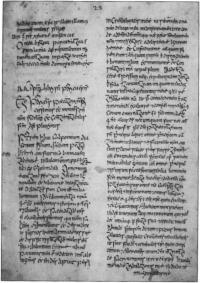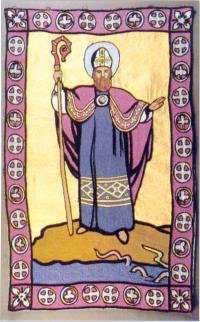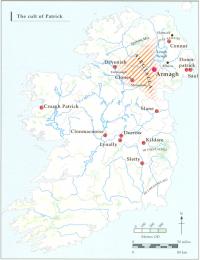The Problem of Patrick (3:1)
Published in Features, Issue 1 (Spring 1995), Pre-Norman History, St Patrick, Volume 3Charlie Doherty

Book of Armagh:opening of Patrick’s Canfession
(Courtesy of The Board of Trinity College Dublin)
Most people if asked about St Patrick would mention one or more of the following: snakes, slavery, Armagh, Slemish, Saul, Downpatrick, Croaghpatrick and, of course, the shamrock. How many would mention the saint’s own writings—his Confession or his Letter to the Soldiers of Coroticus?
We have only one fixed point for fifth-century Irish history. Pope Celestine ordained Palladius bishop and sent him to the Irish believing in Christ in AD 431. His mission is merely a faint shadow in the midlands of Ireland. We have no surviving documents that clearly derive from this mission. By contrast we have two documents written by Patrick. He mentions only one place in Ireland—the Forest of Fochlut by the western sea (most probably north west Mayo) where he was kept as a slave. All the associations mentioned above are found in later writings.
Dawn of documented history
It is symbols that a people remember, symbols that have become part of the rich tapestry of their nationhood. When we are dealing with a Daniel O’Connell or a de Valera there is a wealth of contemporary documentation which allows the historian to get behind the legends and the myths. In the case of St Patrick we are going back to the dawn of documented history in Ireland. There are very few contemporary documents from the fifth or even the sixth century for that matter. Indeed the sources that have survived only increase significantly in number during the course of the seventh century. Hence the ‘problem of Patrick’.
It is not a modern problem. We first encounter documents written about Patrick at the very beginning of the seventh century when information about the saint was collected and the first biography of him was written. The scholars who compiled these materials had as much difficulty as ourselves in discovering accurate details about Patrick and his life. The missionary period was by now more than 200 years in the past. Apart from the missionary clergy themselves and the Irish people that they educated the population was illiterate. The clergy serving the incipient Christian communities, for a long time isolated in a sea of paganism, would have been engaged in producing copies of the basic liturgical books needed to carry out their ministry. It must have taken a considerable length of time for churches to become sufficiently wealthy and secure to begin the process of reflection upon their origins.
‘National apostle’
In the seventh century contemporary clergymen sought to establish Patrick as the ‘national apostle’. By the time we get our first document dealing with this matter we can see that the process is already well under way. But a distinction must be made between this activity and the work and writings of Patrick himself.
Patrick’s ancient biographers were not simply writing the ‘life’ of their saint. They were engaged in expanding the cult of Patrick so their writing tells us more about the churches fostering the cult and their relationship with the other great cults of seventh-century Ireland: St Brigit’s at Kildare, St Colum Cille’s at Iona and St Ciaran’s at Clonmacnoise, to mention only the most powerful. An important aim of this writing was propaganda. The historian’s first priority is to understand this material for what it is, for what it tells us about seventh-century church politics and its relationship with the world in seventh-century Ireland.

St Patrick,portrayed in the act of banishing snakes from Ireland – banner by Jack B. Yeats in Clonfert Cathedral,
County Galway.
Sectarian interest
From the late sixteenth century until very recently the debate about St Patrick has been coloured by sectarian interest. The Church of Ireland in the seventeenth century was anxious to trace its origins to Patrick himself. James Ussher, a nephew of Richard Stanyhurst, became archbishop of Armagh in 1625. He was an erudite scholar and wrote much on Irish church history, although it was strongly polemical in tone. He stated his purpose in the introduction to his work, A Discourse of The Religion Anciently Professed by The Irish and British (Dublin 1631):
…but as far as I can collect by such records of the former ages as have come unto my hands (either manuscript or printed) the religion professed by the ancient bishops, priests, monks, and other Christians in this land, was for substance the very same with that which now by public authority is maintained therein, against the foreign doctrine brought in thither in latter times by the bishop of Rome’s followers.
And those same followers he saw with all greediness embrace, and with a most strange kind of credulity entertain those lying legends, wherewith their monks and friars in these latter days have polluted the religion and lives of our ancient saints.
Despite this Ussher was in contact with Catholic scholars of the period.
At the same time the Irish Franciscan scholars at Louvain were busy preparing the Acta Sanctorum Hiberniae to the same standards and with the encouragement of the early Bollandists. John Colgan published his Triadis Thaumaturgae, a collection of documents relating to Patrick, Brigit and Colum Cille in Louvain in 1647. However the scientific analysis of the ‘lives’ of saints was to lie a long time in the future. Indeed Archbishop Healy’s The Life and Writings of St. Patrick (Dublin 1905) was a work in which legend and history were interwoven to produce, in the words of Daniel Binchy, ‘the pure milk of tradition, undiluted by Bury’s “rationalism”’. J.B. Bury, the historian of the Roman Empire, had also published a book on Patrick in the same year in London, The Life of St. Patrick and His Place in History. This was the first scientific analysis of the ‘problem’ of Patrick and it set the standard for work during the following decades.
The publications on St Patrick in 1961 (commemorating the anniversary of his death, or rather one of the possible dates for his death in the Irish annals) and in the years just before contained echoes of sectarian concerns on the one hand, and fears of the possible demotion of Patrick as the national apostle on the other. The lack of scholarly detachment displayed in the writings of these scholars stimulated Binchy to write his devastating critique on the current state of Patrician studies: ‘Patrick and His Biographers Ancient and Modern’, in Studia Hibernica. This was indeed a watershed in Patrician studies. It made a distinction between the saint’s own writings and those of later times purporting to be about him. Scholars could no longer use later legend to flesh out the bare bones of Patrick’s own writings.
The cult of Saint Patrick
The earliest evidence of the cult of Patrick is found in a hymn, Audite Omnes, probably the work of bishop Colmán Elo (d. 611). Colmán belonged to an obscure tribal group called the Dál Saillne who inhabited the plain lying between the north-east corner of Lough Neagh and Slemish mountain in County Antrim. At the heart of this territory lay the church of Connor where he had spent some time. Colmán founded the church of Lann Ela (Lynally), a few miles south-west of Durrow in County Offaly in the midlands. These two churches were to remain in close contact during the following centuries. It is not surprising that Colmán, coming from the very heart of Patrick country, should have written a hymn in his praise. And it is through his foundation in the midlands that the cult of Patrick spread at the very beginning of the seventh century.
The earliest singing of the cult of Patrick is associated not with Armagh but with the east of Ulster. There is further evidence (in the work of Muirchú to be discussed below) that the churches of Saul and Downpatrick in the south-east of Ulster had the earliest claims to the headship of the cult, but that by the 630s Armagh had begun to make a challenge to their position.
 Armagh’s propaganda
Armagh’s propaganda
In a document called the Book of the Angel we first come across Armagh’s propaganda. This is a composite document; the greater part was probably composed c. 640. In this Armagh attempted to define a territory within which she exercised immediate ecclesiastical overlordship. It stretched from Slemish in County Antrim to the hills just north of Slane in County Meath.
These expansive claims are likely to have arisen out of political expediency in the seventh century. In the famous battle of Mag Roth (Moira in County Down) in 637 the Ulaid, the Ulstermen (of Down and Antrim), suffered a massive defeat from which they never recovered. In the aftermath the Airgialla—a confederation of tribal groups settled around the Sperrin mountains and in Fermanagh and Monaghan in Ulster—achieved a degree of independence that they retained until their defeat by the Uí Néill in the battle of Leth Cam in 827. Armagh herself was situated within, and was surrounded by, Airgiallan territories. It is hardly a coincidence that the rise of Armagh to dominance follows the fortunes of the Airgialla as they emerged from under the overlordship of their political masters, the Ulaid.
The Book of the Angel, then, can be seen as Armagh’s attempt to make a bid for the headship of the cult on the strength of the new patronage of the Airgialla. She claimed to be the chief ecclesiastical court of appeal in the island; claimed jurisdiction over diocesan churches, and claimed a special tax from all churches—even monasteries—since Patrick had converted ‘all the Irish tribes’. Just before this time the clergy of Armagh (as well as those of other northern
 Head-reliquary of St Patrick. |
churches) had made contact with Rome concerning the problem of the proper date on which to celebrate Easter. As a result she acquired relics of the principal martyrs of the church. A special ‘basilica’ was built to house these precious relics and we are given a glimpse of the liturgy associated with it. What made these relics ever more important was the fact that Armagh did not possess the body of her saint. In the light of this her ultimate success is all the more remarkable.
Spread of the cult
The cult of Patrick spread in the midlands at this time, particularly among those churches that felt themselves to be under threat. It is clear from the sources that all figures of the missionary period were, by the seventh century, simply shadows from the past. Some cults were fading into oblivion. It was thus with the cult of Palladius, as it was with the cults of other early missionaries. In the ninth-century Book of Armagh (which contains the main Patrician archive) we are told that ‘Palladius was Patrick by another name’. It was not the clergy of Armagh who made this equation but those of the midlands who needed a powerful but distant protector. The cult of Patrick had an enormous advantage over all others. The saint had left personal and very intimate documents that provided a link with the distant missionary period. Through them he continued to speak to the Irish. It is for this reason that disadvantaged churches began to look to Armagh. It also resolves the paradox that much of the propaganda written on behalf of Armagh comes from the scholars of the midlands.
It did not take the clergy of Armagh very long to realise that it could be to their advantage to accept the allegiance of distant churches. By the time Tírechán is writing in the late seventh century there was a deliberate policy of searching out churches which ‘ought’ to belong to the Armagh federation, and of claiming back those that had been appropriated by the other great churches of the period—Clonmacnoise, Kildare, Iona, Clones and Devenish. Armagh’s greatest rival for ecclesiastical headship of the country was Kildare but by the late seventh century political circumstances dictated that she could not match the power of the church of Patrick.
The triumph of Armagh
The triumph of Armagh is most eloquently expressed in the biography of Patrick written by Muirchú, c. 688, or shortly thereafter. Here again the stimulus for this work lay not in Armagh but in the church of Sléibte (Sletty, one mile north of Carlow town just inside the border of County Laois) in distant Leinster. The bishop of Sletty was Áed mac Brocáin, a member of the Uí Bairrche. His tribal group was under severe pressure from the rising dynasties of the Uí Chennselaig to the south and the Uí Dúnlainge to the north. During the abbacy of Segene (661-688) Áed had gone to Armagh and made submission to him. His successor Conchad had this agreement confirmed by the next abbot. Áed himself had retired to Armagh and died as an anchorite there in 700. It was almost certainly while he was in Armagh that he engaged Muirchú to write the ‘life’ of Patrick. What traditions that remained about Palladius (traditions that were probably brought north by Áed) were now incorporated into the story of Patrick.
It is in Muirchú’s biography that we see the rivalry between Armagh on the one hand and Saul and Downpatrick on the other. While it was quite uncertain at this time where Patrick was buried, it was clearly not at Armagh; and both Saul and Downpatrick had better claims. Indeed Saul has probably the greatest claim, and was most likely the earliest cult-centre before being overshadowed by Downpatrick. Muirchú’s skill lay in harmonising relations among these churches and, in particular, in confirming Armagh as the centre of the cult. He also endowed Patrick with the attributes of the secular hero and ensured that the cult was elevated to that of a ‘national’ apostle. This is a process which did not begin with Muirchú since we find that Tírechán had Patrick meet the ancestral figures from whom the current ruling dynasties took their names. As well as protecting the weak, the Armagh propagandists flattered the powerful.
What does this investigation tell us about Patrick? Little directly, but by analysing the cult of the saint we can be more confident that the home territory of his ministry lay within the modern counties of Down and Antrim. As he tells us himself he travelled widely to reach his Christian communities. No doubt there were churches established by him in outlying districts of which Armagh is likely to have been an important one. But, as has been suggested, it was good fortune—and astute politics—rather than any status conferred on it by Patrick that allowed Armagh to emerge as the most important church in Ireland by the end of the seventh century.
Patrick’s lack of learning?
Our approach to Patrick, the historical human being, must be through his own writings which are profound spiritual statements. The qualities of this great saint shines through them. Patrick’s humility—that what he does and what he has achieved are not as a result of his will but that of God acting through him—permeates his writings. Until recently scholars have taken Patrick’s claim of lack of learning at face value and declared him to be a man of one book—the Bible. Now scholars contributing to Daniel Conneely’s The Letters of Saint Patrick (Maynooth 1993) argue that his reading of the Fathers was extensive and they have examined his theology and reassessed his intellectual stature. Even more strikingly D.R. Howlett has argued for a very sophisticated use of Latin by Patrick in his The Book of Letters of Saint Patrick the Bishop (Dublin 1994). If these theses were to be accepted by scholars (and they will undoubtedly stimulate intense debate) then our view of Patrick will greatly change.
Finally the work of Liam de Paor, Saint Patrick’s World (Dublin 1993), as usual, has many insights. He has pointed to the priest Segetius and the deacon Auxilius who attended councils in southern Gaul in 441/442 as likely companions of Palladius mentioned by Muirchú. He has also made the interesting suggestion that Patrick, like Palladius, came to pre-existing communities of Christians in the north-east of Ireland and that the reason for his difficulties with his seniors was that he went beyond his remit to pagan territory since missions to pagans were not allowed at this time. It should be kept in mind, however, that Prosper of Aquitaine, from whom we learn almost all we know about the Palladian mission, almost certainly met Palladius in Rome in 431. Prosper was the first person in the Christian church, some years later, to write a treatise on the question of salvation for all men and the idea of missionary activity. There surely was a debate about the validity of missionary activity at the time and it can hardly be a coincidence that the first to write on this subject was the one man who tells us about the spread of Christianity outside the limits of the Roman Empire. Unlike the mission of Palladius to existing groups of Christians, Patrick’s mission may have been to pagans from the start; and it is not beyond the bounds of possibility (although it could not be demonstrated) that Prosper was aware of that too.
Charlie Doherty lectures in early Irish history at University College Dublin.
Further reading:
J.B. Bury, The Life of St. Patrick and His Place in History (London 1905).
D. Binchy, ‘Patrick and His Biographers Ancient and Modern’, in Studia Hibernica 2 (1962).
D. Conneely, The Letters of Saint Patrick (Maynooth 1993).
L. de Paor, Saint Patrick’s World (Dublin 1993).
















